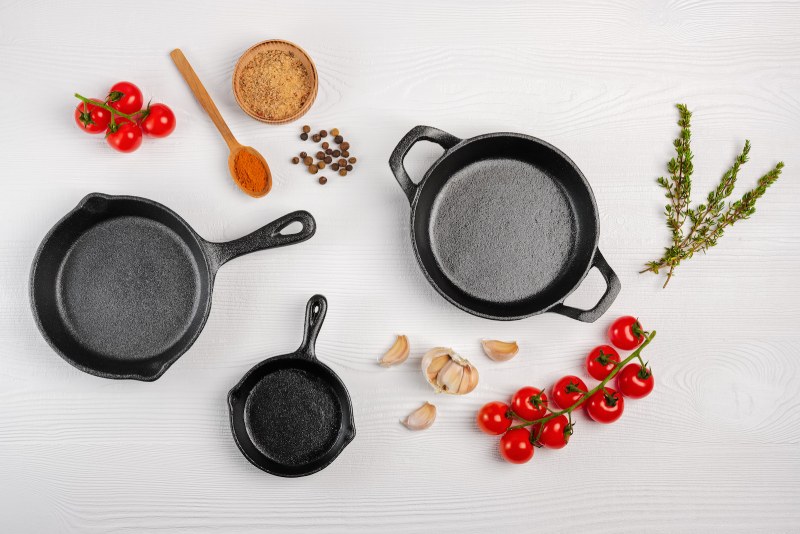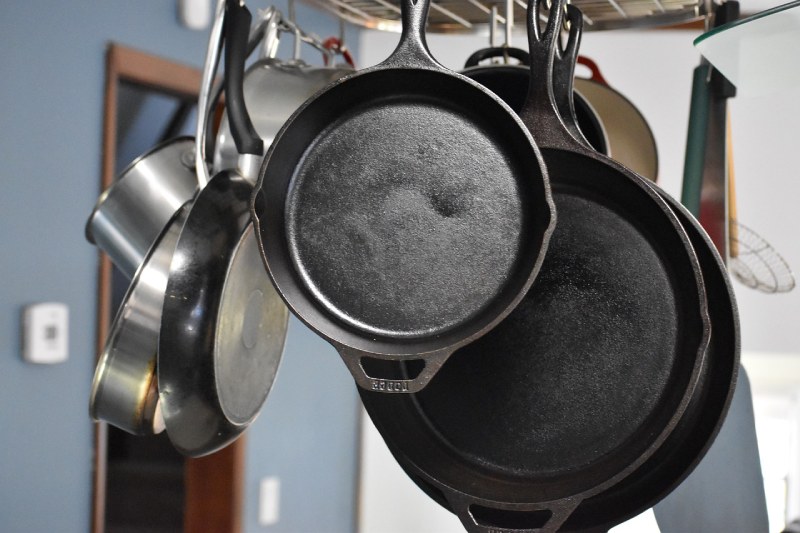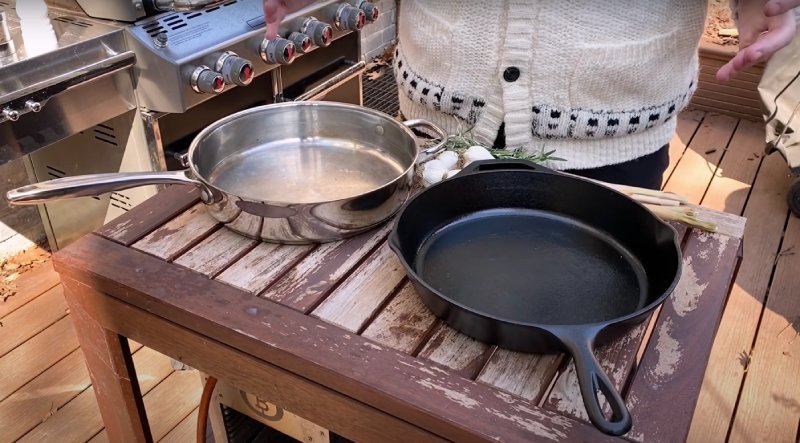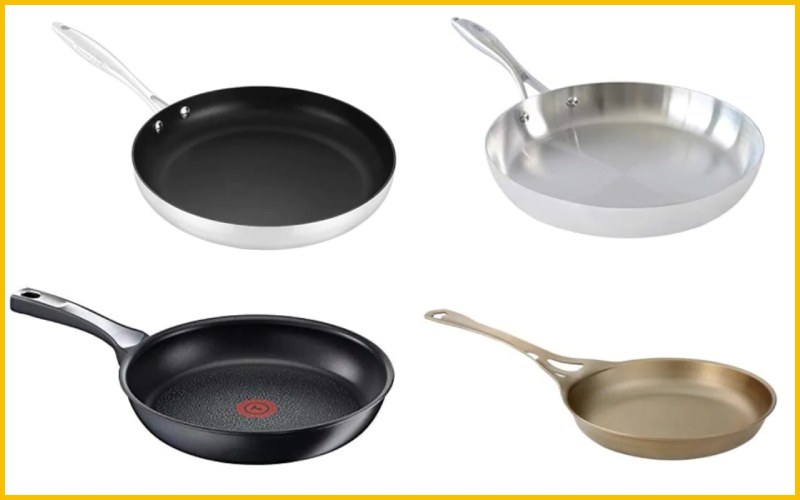Choosing the suitable material for your gas stove can take time and effort. Knowing what will work best for you and your kitchen needs can take time and effort with so many options available. Cast iron vs stainless steel are two of the most popular materials used in gas stoves today, each offering unique benefits, but which one is better?
In this blog post, we’ll examine cast iron and stainless steel stoves in depth to help you determine the best choice for you. We’ll cover topics such as heat retention capacity, durability, ease of cleaning, and overall cost, so read on to learn more about these two popular materials when cooking with gas!
History of Cast Iron Cookware
The history of cast iron cookware dates back to the 5th century B.C. when early people were first known to have used the material in their cooking. Cast iron was a popular choice for many centuries due to its durability, heat retention properties, and ability to retain heat even when exposed to open flame.
Over time, artisans developed techniques that improved cast iron’s strength and made it more suitable for cooking. By the 18th century, cast iron had been widely adopted as an essential kitchen tool in Europe and North America.
In the 19th century, improvements in designing and manufacturing processes increased production efficiency and allowed mass production of cookware sets of various sizes and shapes. During this time, cast iron cookware became a popular household item. With its high heat tolerance, durability, even cooking surface, and ability to withstand extreme temperatures, cast iron was quickly adopted for use in both residential kitchens and commercial restaurant settings.

History of Stainless Steel Cookware
Stainless steel cookware has existed since the early 1900s and is popular among home cooks. It’s also regularly used in commercial kitchens due to its durability and ability to withstand high temperatures.
French metallurgist Pierre Berthier developed the first stainless steel cookware in 1913. He wanted to create an alloy that would be both lightweight and non-corrosive. The result was an iron-chromium alloy with high resistance to corrosion and oxidation, thus making it ideal for use in kitchen utensils. This type of alloy is what we know today as stainless steel.
Early versions of stainless steel cookware were made from 18/8 (18% chromium and 8% nickel) or 18/10 stainless steel. This alloy is still used today because of its durability and corrosion resistance. As technology improved over the years, stainless steel cookware began to be produced in different grades with varying levels of quality.
Today, stainless steel is one of the most popular materials used in cookware. With proper care and maintenance, it can last a lifetime and will remain beautiful for many years to come. Stainless steel cookware has become a staple in home kitchens worldwide, making it an indispensable tool for modern cooks everywhere!
Material Properties
Cast Iron
Cast iron is an alloy of more than 2% carbon and other components, such as silicon and sulfur. It is known for its strength, wear resistance, and extreme durability. Cast Iron has a high melting point, making it ideal for high-temperature environments.
It also possesses good corrosion resistance due to its ability to form a protective oxide layer on its surface. In addition, cast iron offers excellent machinability compared to other metals, allowing for precise details and complex shapes with relative ease. Applications include machine tools, automotive components, valves, pumps, and general industrial uses.
Composition and manufacturing process
Cast iron is made by melting pig iron, scraps of other metals, and limestone in a furnace. The molten alloy is then poured into molds to form its desired shape. Depending on the application, elements may be added to the mix before the metal is cast.
For example, chromium or nickel can be added for increased strength or corrosion resistance. The casting process also allows for great flexibility in terms of design and customization. This makes cast iron ideal for many applications requiring specific shapes or sizes.
Stainless Steel
Stainless steel is an alloy of iron, chromium, and other elements. It is well known for its superior corrosion resistance and strength compared to other metals. Stainless steel also has excellent thermal conductivity and can withstand extreme temperatures without deforming or corroding.
This makes it ideal for manufacturing components requiring high temperature or chemical resistance. Applications include medical instruments, automotive parts, kitchenware, and aerospace components.

Composition and manufacturing process:
Stainless steel is made by melting iron ore in a furnace with chromium and other elements such as nickel or molybdenum. The molten alloy is then poured into molds to form its desired shape. Depending on the application, details may be added to the mix before casting the metal.
For example, nickel can be added for increased strength or corrosion resistance. The casting process also allows for great flexibility in terms of design and customization. This makes stainless steel ideal for many applications requiring specific shapes or sizes.
Pros and Cons of Cast Iron on Gas Stoves
Benefits
- Heat retention: Cast iron retains heat longer than other materials, making it an excellent choice for gas stoves. This means that when using a cast iron skillet on a gas stove, the heat will stay consistent and help to ensure even cooking.
- Durability: Cast iron Cookware is highly durable and can last for generations if properly cared for. It’s heavier than stainless steel or aluminum cookware, so that it won’t get damaged easily from frequent use.
- Non-Reactive: Cast iron is non-reactive with food, so you don’t have to worry about the food taking on any metallic taste.
- Heat Distribution: The heavy weight of cast iron ensures that the heat is evenly distributed throughout the pan when heated, allowing for more consistent cooking.
- Weight: The main drawback to cast iron cookware is that it’s heavy, so it can be harder to handle and move when cooking on a gas stove. It may also require two people to lift the skillet from the stovetop.
- Non-stick surface with seasoning: Cast iron requires regular seasoning and care to maintain its non-stick surface. If not properly maintained, the skillet will lose its non-stick coating and may require additional seasoning before cooking.
Drawbacks
- Weight: Cast iron is much heavier than other cookware materials, so it can be challenging to handle when cooking on a gas stove. It may also require two people to lift the from the stovetop.
- Maintenance requirements: Cast iron requires regular seasoning and care to maintain its non-stick surface. If not properly maintained, the skillet will lose its non-stick coating and may require additional seasoning before cooking.
- Potential for rust: Cast iron is susceptible to rust and may require regular oiling or the use of a rust remover.
Cast iron cookware provides excellent heat retention, durability, and even heat distribution when used on gas stoves. However, it does require more maintenance than other materials and is heavier to handle. Careful consideration of these factors should be taken when determining if cast iron is the best choice for your gas stove cooking needs.

Pros and Cons of Stainless Steel on Gas Stoves.
Benefits
- Lightweight: One of the primary benefits of stainless steel on gas stoves is it’s lightweight. Stainless steel cookware is much lighter than traditional cast iron cookware, making it easier to move around and use in the kitchen.
- Low maintenance: Stainless steel is straightforward to maintain and does not require special cleaning. It can be easily wiped down with a cloth or sponge and mild soap and water, making it an ideal choice for busy cooks who do not have much time to spare.
- Durability: Stainless steel cookware is highly durable and can last for years with proper care. It is also more resistant to staining than other materials, so that it will look great for extended periods.
- Corrosion resistance: Stainless steel is resistant to corrosion and rust, making it a good choice for those looking to use their cookware in wet or humid environments.
Drawbacks
- Uneven heat distribution: Stainless steel is not known for its even heat distribution, meaning some parts of the food may be cooked more quickly than others. This can lead to unevenly cooked dishes and can cause problems with baking.
- Potential for food to stick: Another potential drawback is the tendency of food to stick to stainless steel cookware, making it more challenging to clean than other materials. This can be counteracted by properly seasoning the pan before use.
- Prone to discoloration: Finally, stainless steel is prone to discoloration and staining over time. This can detract from the appearance of the cookware and make it less attractive.
Cast Iron Cookware Types
- Skillets: Skillets are one of the most famous pieces of cast iron cookware available due to their versatility. They come in various sizes, from small 8-inch skillets to large 16-inch skillets, so there’s something for everyone. The flat surface and rounded sides make them great for everything from sautéing vegetables to searing steaks.
- Griddles: Griddles are another versatile piece of cast iron cookware perfect for making breakfast foods like pancakes or bacon. Like skillets, they come in various sizes with flat surfaces and low edges preventing food from spilling onto your stovetop. The ridged variety of griddle pans adds even more versatility, allowing you to make steakhouse-style seared marks on your food.
- Dutch Ovens: Dutch ovens are a must-have for any kitchen. They come in many sizes, from small 2-quart varieties to larger 8-quart models perfect for making stews and other one-pot meals. The thick walls and tight lid help the oven retain heat, creating a moist cooking environment for slow-cooking meats.
- Grill Pans: Grill pans are similar to griddles but feature raised edges and ridged surfaces that simulate an outdoor grill. This makes them perfect for getting those delicious char marks on meats and vegetables without having to fire up the barbecue.
Stainless Steel Cookware Types
- Saucepans: Saucepans are available in a wide range of sizes and shapes. They are perfect for making sauces, soups, stews, and hot cereals. Saucepans feature a lid with a handle that fits snugly over the top edge of the pan to keep moisture inside while cooking.
- Fry pans are typically round or oval-shaped with slanted sides, allowing you to use them for sautéing vegetables or browning meats. They come in various sizes and depths and feature a long handle attached to one side.
- Stock pots: They are tall and have straight sides that make them ideal for boiling large amounts of liquids like stock or pasta. These vessels usually come with lids, so you can quickly bring food to a boil or simmer.
- Saute pans: Saute pans are wide, shallow vessels with one long handle and straight sides that make them perfect for sautéing or browning foods. The sloped sides allow you to stir the food while cooking quickly.
- Multi-ply cookware: Multi-ply cookware is usually constructed with an aluminum core that helps distribute heat evenly. The exterior layers are typically stainless steel but can also be copper or enameled cast iron. This type of cookware is heavier than other cookware and can often be used on the stovetop or in the oven. It’s perfect for slow-cooked dishes.
Price Comparison
The average cost of cast iron cookware
Cast iron cookware is an excellent choice for long-lasting, durable kitchenware. The cost of cast iron cookware can vary greatly depending on the type and size of the pieces you are purchasing and the brand. Generally speaking, an essential 10-inch skillet can range in price from $15 to $50 or more, while a 5-piece cast iron cookware set can range from $85 to $200.
Whether looking for an individual piece or a complete set, it pays to shop around and compare prices to get the best deal. Consider purchasing pre-seasoned or enameled articles, as these will cost more but also tend to last longer and require less maintenance.
Ultimately, the cost of cast iron cookware comes down to personal preference and budget. With some research, you can find a great deal that meets your needs without breaking the bank!
The average cost of stainless steel cookware
Stainless steel cookware is a popular choice for its durability and clean lines. Like cast iron, the cost of stainless steel cookware can vary greatly depending on the type and size of pieces you purchase and the brand. A basic 10-piece set can range in price from $50 to over $200, while an individual part can range from $10 to over $100.
Stainless steel cookware is typically more expensive than cast iron, so this may not be the best choice if you are looking for a budget-friendly option. However, if you have the means and desire quality stainless steel kitchenware, shopping around and comparing prices is still a good idea to get the best deal.
In addition to finding great prices, look for quality and read customer reviews before making your purchase. With proper care and maintenance, stainless steel cookware can last a lifetime!
Environmental Impact
Production and recycling of cast iron
Cast iron is a durable material that can be recycled or reused in many applications. It is also an integral part of sustainable design and production processes because it can be melted down and reused multiple times with minimal loss of quality.
The recycling process for cast iron involves melting the metal and separating impurities from the molten iron to create new alloys. This process reduces greenhouse gas emissions by decreasing the need to extract new raw materials while conserving energy since no contemporary metals must be smelted from ore. In addition, reusing cast iron reduces waste sent to landfills, helping reduce pollution and save resources.
Production and recycling of stainless steel
Stainless steel is one of the most popular and durable materials used for industrial purposes. It is known for being extremely corrosion-resistant, making it ideal for many applications. In addition to its strength and durability, stainless steel has a low environmental impact when recycled.
The recycling process involves melting the old material while separating contaminants or impurities. This helps preserve natural resources and reduce greenhouse gas emissions since no new raw materials need to be extracted from ore before smelting into stainless steel. Reusing stainless steel reduces waste sent to landfills, minimizing pollution and conserving resources.
How to Choose the Best Cookware for Your Gas Stove?
Factors to consider
- Material: Different materials conduct heat differently, so it’s essential to consider the type of cookware you need for your gas stove. Pans made from stainless steel, aluminum, or copper are ideal as these metals spread heat evenly and can handle higher temperatures without damage.
- Size: Consider the size of the burner when selecting a pot or pan. The base should be slightly larger than the burner to ensure even heating and prevent the scorching of foods.
- Weight: Heavier pots and pans provide more efficient heat transfer and may reduce cooking time due to their ability to absorb and retain heat better than lighter cookware pieces.
- Handle Design: Stovetop handles should have a secure grip that won’t slip, even when wet hands grip the handle. The ideal material for stovetop handles is stainless steel, as it stays more relaxed and isn’t prone to breaking or warping.
- Lids: Look for tempered glass or metal lids to withstand high temperatures without cracking or shattering. A well-fitting cover helps retain heat and moisture while preventing splatters and helping direct the heat where you need it most.
- Price: Quality cookware is costly, but affordable options are available if you know what to look for. Do your research beforehand to ensure you get the best product for your money and ensure it will last.
Considering these factors, you can pick the best cookware for your gas stove and enjoy a lifetime of delicious meals. Investing in high-quality cookware is worth the money as it will last longer and make cooking much more accessible. With some research, you’ll find the perfect set for your kitchen.
Conclusion on Cast Iron vs Stainless Steel: Which Is Better for Gas Stoves?
In conclusion, cast iron and stainless steel offer distinct advantages regarding gas stoves. Cast iron offers excellent heat retention properties and is great for browning foods. It is also very durable and can last a lifetime with proper care. On the other hand, stainless steel has superior corrosion resistance and is much easier to clean than cast iron.
Choosing which material to use for your gas stove will depend mainly on personal preference. There are pros and cons associated with each option that needs to be weighed when making the decision. Both materials should provide you with many years of satisfaction if chosen properly!
See more:

